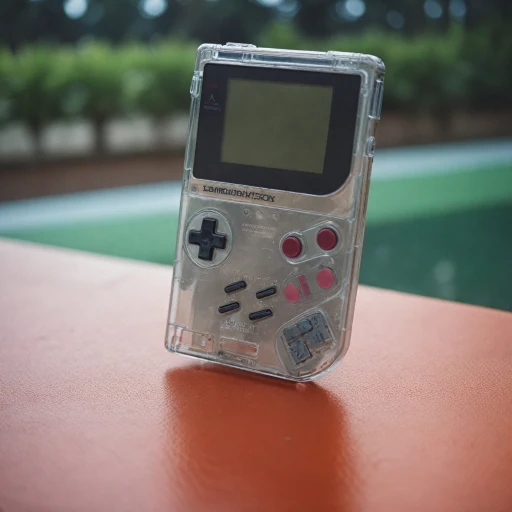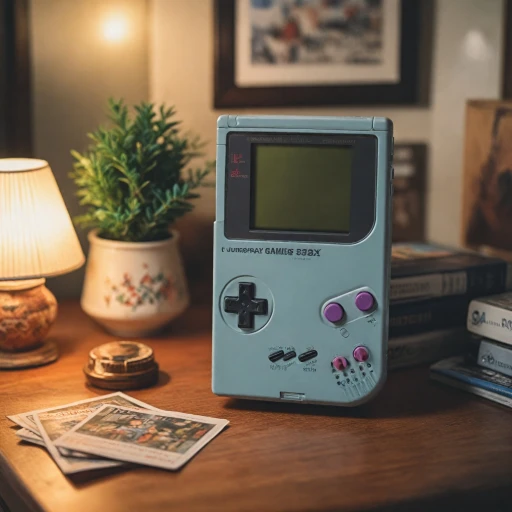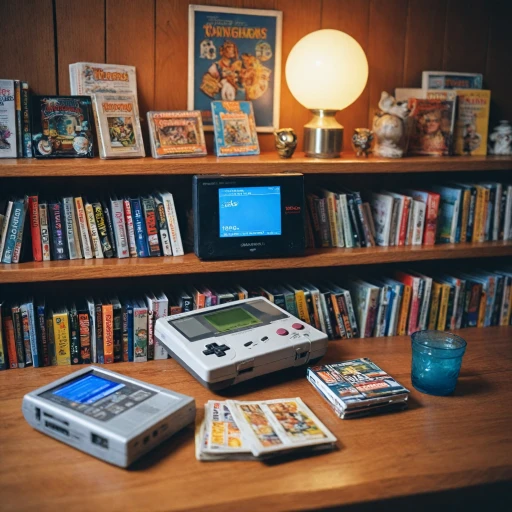
The Evolution of PlayStation Handheld Consoles
The Dawn of Handheld Gaming with Sony
The evolution of PlayStation handheld consoles is an intriguing journey for enthusiasts across the globe. Sony's foray into the handheld gaming market with the PlayStation Portable (PSP) marked a new era in portable entertainment. Released first in the United States in March 2005, the PSP was a game-changer, offering robust console-like experiences in users' hands.
Back then, with its vibrant color screen and impressive battery life, the original PSP set new standards. The media capabilities, including playing PSP games, videos, and music, made it an all-around media device. Supporting these abilities were the memory stick duo and pro duo, which allowed users to expand storage for more portable PSP enjoyment.
The journey didn’t stop there; the handheld's will to innovate led to the introduction of improved models bearing better battery life, design improvements with enhanced buttons, and stronger system software. Sony bolstered the PlayStation Network, providing gamers with improved connectivity and the option to download games directly from the online store.
Innovative Features Across Generations
Throughout each iteration, from the original PlayStation Portable to the more refined PlayStation Vita, Sony continually demonstrated a commitment to enhancing the gaming experience. The new consoles improved further with better screen quality, increased processing power, and a wider selection of games. The incorporation of remote play further leveraged the power of the PlayStation console, allowing gameplay across different screens.
For those interested in exploring portable gaming consoles, the PlayStation handheld line-up serves as a guide to understanding impactful design choices and technological progression in the realm of handheld gaming.
Key Features of the Latest PlayStation Handheld Console
Unveiling the Modern Marvels of PlayStation Handhelds
The latest in the PlayStation handheld series showcases a variety of cutting-edge features that distinguish it from its predecessors. With each iteration, Sony has made strides in enhancing the functionality and overall experience of their handheld consoles, and this latest release is no exception.- Enhanced Display Quality: The new console sports an impressive display with vivid color reproduction and high resolution, ensuring every game looks as stunning on the go as it does on your TV screen.
- Ergonomic Design: Emphasizing portability, the design has been crafted to provide a comfortable grip for extended gaming sessions.
- Power and Battery Life: Optimized for longevity, the console provides an improved battery life, allowing for more hours of uninterrupted play. The battery system has undergone significant enhancements from previous models, ensuring that the portable PSP continues to be a reliable companion on your travels.
- Connectivity and Ports: Featuring multiple port options including USB and memory stick pro duo, the console allows seamless connectivity and easy data transfer. Remote play capabilities further enrich the user experience, providing a bridge to the home console ecosystem.
- System Software and Game Library: Equipped with the latest system software, it enables smoother operation and access to a vast library of games, including classic PSP games. Users can enjoy popular titles available on the PlayStation Network store, making the transition to this new device seamless for long-time fans.
- Button Configuration: Redesigned buttons enhance precision and responsiveness, catering to both seasoned gamers and newcomers alike. This feature proves crucial when engaging with intense gaming scenarios or exploring vintage PSP favorites now available on the platform.
Comparing PlayStation Handheld Consoles to Competitors
Analyzing PlayStation Handheld Consoles Against Their Competitors
When we dive into the world of handheld gaming consoles, it is crucial to scrutinize the competition to understand the strengths and weaknesses of the PlayStation handheld consoles against them. PlayStation's newest offerings have brought fresh updates, but how do they hold up against other renowned products like the Nintendo Switch or the Steam Deck? Firstly, PlayStation handhelds, such as the Sony PSP and the PlayStation Portable, have always been synonymous with quality and innovation. Their unique features—like the traditional Sony buttons, portable design, and vibrant color screens—have consistently set them apart. Additionally, the integration with the PlayStation Network and remote play capabilities enhances the gaming experience, offering loyal PlayStation users extra incentives to stick with their brand. Battery life is another important factor when comparing these consoles. The PSP battery life has often been praised for its reliability, although recent entries face intense competition from devices like the Steam Deck, which boasts an impressive battery setup suitable for extended gameplay. When it comes to storage, previous models used the Memory Stick Pro Duo for expanding storage, which was great for its time. However, today’s gamers may lean towards the more seamless storage solutions often provided by competitors. The PlayStation handheld range stands out with its extensive library of PSP games as well as the ease of access to exclusive titles via the PlayStation store. However, the Nintendo Switch's ability to port various games and its innovative hybrid system—allowing transition between handheld and console gameplay—continues to be a strong draw for many gamers. Moreover, PlayStation consoles showcase exceptional system software that ensures smooth interactions and access to various features. Yet, some users report challenges in terms of connectivity and updates compared to competitors like the Steam Deck, which is tightly integrated with PC gaming ecosystems. For gamers looking to explore a broader range of retro gaming options, other devices may be worth considering. Exploring the Best Local Spots for Retro Gaming Enthusiasts offers great insights into alternative gaming avenues. In conclusion, while the PlayStation handheld gaming system possesses remarkable features and an enduring legacy, the fast-evolving landscape and innovations from competitors ensure that potential buyers have attractive choices depending on their preferences and gaming needs.Benefits of Owning a PlayStation Handheld Console
The Benefits of Choosing Sony's Portable Gaming Option
Owning a PlayStation handheld console, particularly in the ever-evolving landscape of portable gaming, comes with numerous advantages. For starters, these consoles offer a wide array of PSP games that cater to various preferences and age groups. This diverse selection allows players to access their favorite PlayStation network titles on the go. One of the standout features of the PlayStation handheld is its design for network portability. The quality of PSP batteries ensures extended gaming sessions without the constant worry of running out of power quickly. This makes them ideal companions for long trips or commutes. The convenient USB ports and memory stick compatibility, like the stick Pro duo, also make it easy to expand storage and transfer data between devices efficiently. Another benefit is the inclusion of innovative system software, which brings features such as Remote Play. This allows owners to stream games from their main PlayStation console directly onto their handheld device, a unique capability not readily available from competitors. Plus, the handheld's ability to use accessories such as the PlayStation portal and PSP battery adds to its versatility. The appeal of PlayStation’s color options available upon a console's release, combined with the classic design of buttons reminiscent of the original Sony PSP, draws in nostalgic gamers and new-age players alike. This makes it a store star come March release months, enticing not just in the United States but globally. While alternatives such as the Steam Deck offer a formidable handheld gaming experience, the compactness and portability of the PlayStation handheld make it a choice worth considering for gamers who prioritize convenience without sacrificing performance. Its role in shaping the landscape of handheld gaming is marked by a legacy of quality and innovation that continues to influence the gaming industry today.Challenges and Limitations of PlayStation Handheld Consoles
Addressing Common Hurdles of PlayStation Handheld Devices
As exciting as PlayStation's handheld history has been, certain challenges and limitations have persisted with each iteration. One prevalent issue has often been the battery life. Owners of devices such as the original PSP and the subsequent portable PSP versions frequently reported the need to carry a charger or a spare PSP battery, especially during long gaming sessions or extended travel.
Furthermore, the design and quality of controls have been a frequent topic of critique. While the portable nature of these consoles requires compactness, it sometimes comes at the cost of playing comfort. Players often find the buttons and sticks less durable than those on full-sized PlayStation consoles.
Another significant challenge lies in software compatibility. The advancement of system software across different models sometimes leads to compatibility issues with older PSP games. This situation potentially diminishes the allure of past PlayStation Portable and PSP games, unless appropriately updated or supported by the PlayStation Network.
Storage considerations also emerge as a limitation for handheld gaming enthusiasts. Despite the existence of various memory stick pro duo options, the limited onboard storage can necessitate frequent transfers and management of game data. This becomes increasingly apparent with the popularity of digital purchases via the store, which requires adequate space to host and enjoy a variety of games.
Lastly, many consumers voice concerns over pricing and availability. Especially when compared to competitors like the Steam Deck, the cost of entry and ongoing investment can be hefty. Remote play functionality, while innovative, can also vary in reliability depending on one's internet connection, further complicating user experience for some players.












